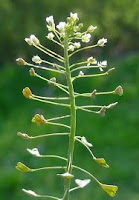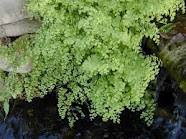Kale is a green leafy vegetable with ruffled, crinkly leaves which may be reddish as in the Red Russian Kale which was introduced into the USA Siberia back in the 19th century. The fact that it can grow in such a cold place as Siberia illustrates the point that it was a popular green vegetable in northern Europe in the Middle Ages because it can withstand severe weather conditions. It thrives in Scotland
 In the
In the This leafy green is a precursor of the ‘head’ cabbage which has been developed by human cultivation. It shares its genus with the cauliflower, cabbage, broccoli, brussel sprouts, and kohlrabi, all of which are Brassica oleracea variants. Kale fell out of favour when the cabbage became popular and has since been a second-class brassica. However it is packed full of nutrients and is another of Nature’s superfoods along with kiwi fruit and pomegranates, and of course, cranberries. It actually looks a little like spring cabbage or spring greens but they do not have the crinkly leaves of kale.
 My grandfather was very disparaging of kale, saying it was fit only for animal fodder, but we now know that it has 4 times more magnesium and 5 times more calcium than an equal amount of brussel sprouts, 17 times more vitamin C than carrots, almost double the magnesium content of spring greens and more folate than broccoli. When kale and cabbage are raw, kale has 7 times more carotene than cabbage too. Kale is low in calories and has no fat or cholesterol in it. It is at its most nutritious when steamed, even though it can be eaten raw. If it is steamed it has cholesterol lowering effects in the body.
My grandfather was very disparaging of kale, saying it was fit only for animal fodder, but we now know that it has 4 times more magnesium and 5 times more calcium than an equal amount of brussel sprouts, 17 times more vitamin C than carrots, almost double the magnesium content of spring greens and more folate than broccoli. When kale and cabbage are raw, kale has 7 times more carotene than cabbage too. Kale is low in calories and has no fat or cholesterol in it. It is at its most nutritious when steamed, even though it can be eaten raw. If it is steamed it has cholesterol lowering effects in the body. Scientists have identified 45 different flavonoids in kale and these have anti-inflammatory effects and also antioxidant ones. This means that the free radicals which damage healthy cells are combated and so kale can help in our fit against some cancers, notably, breast, colon, bladder, ovarian and prostate ones. The bioflavonoids kaempferol and quercetin are present and kale also is a source of Omega-3 fatty acids which are usually found in oily fish such as salmon and mackerel. As for vitamins, kale contains vitamins K, A, and E as well as C and apart from calcium also contains the minerals manganese, copper, potassium and iron; it also has the B-complex vitamins, B1 (thiamin), B2 (riboflavin), B3 (niacin) and B6 (pyridoxine). Amino acids are also present, including tryptophan.
 The vitamins and amino acids as well as the minerals combine to fight the onset of Age-related Macular Degeneration which is responsible for poor vision in the elderly, particularly affecting women in the
The vitamins and amino acids as well as the minerals combine to fight the onset of Age-related Macular Degeneration which is responsible for poor vision in the elderly, particularly affecting women in the The Scots authors of the early 20th century, J. M. Barrie (who wrote “Peter Pan”) among them and who wrote nostalgically and sentimentally about the older traditions and way of rural life in Scotland
Certainly my grandfather was not the only person to look down their noses at kale, but it is very beneficial and deserves to be added to our diets.
KALE WITH PASTA
Ingredients
500 gr (1 lb) kale, large thick veins removed
2 small red onions finely sliced
4 cloves garlic, finely sliced
1 small tin anchovies, drained and rinsed
25 gr pine nuts
1 glass white wine
1 tsp chilli powder
500 gr pasta (dry weight) of your choice, cooked
Parmesan cheese, grated
1 lemon
Method
Wash the kale and drain, then put it in a bowl with a little water clinging to it.
Heat 3 tbsps of the olive oil in a pan with a lid and when hot, add the chilli powder and onions and fry stirring for a few minutes. Cover the pan and turn the heat down low and cook for a further 7 minutes before adding the garlic and pine nuts. Coat these evenly in the oil and cook, stirring for 4 mins.
Meanwhile cut the kale into slices, about 2 inches wide.
Snip the anchovy fillets into small slivers.
Add the remaining olive oil to the pan and the kale and coat with oil. Stir well and add the white wine, salt and pepper to taste.
Cover the pan and cook on a low heat until the kale is tender, about 20 minutes.
After 15 minutes add the anchovies and stir well to mix.
Serve with the cooked pasta and grated Parmesan and garnish with lemon wedges.
This has Taste and is a Treat.




















































